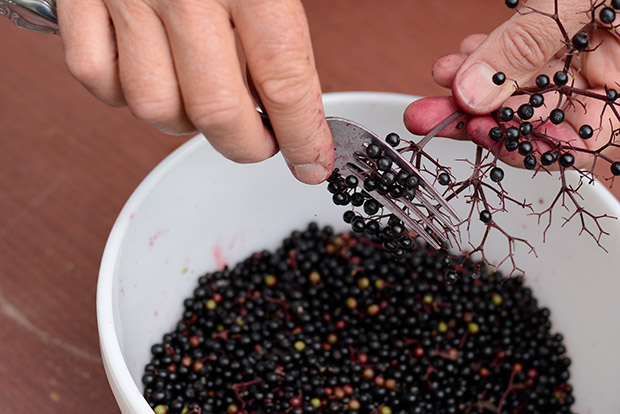Forager’s Jam: Elderberry, Kawakawa and Plum preserves

Use wild fruit to make this sweet and slightly peppery favourite to add to your pantry.
Words: Kristina Jensen
Oh how I love the adventure and alchemy of foraging! When a summer harvest of three delightful ingredients came together in my hands in my favourite locale, the Marlborough Sounds, my brain fairly fizzed with the culinary possibilities.
The elderberries my husband and I collected flourished at shoulder height – until a fallen pine served as a useful climbing frame. This frame, and much of the actual tree, is clothed in an almost-impenetrable sheath of blackberry and muehlenbeckia which makes for delicate footwork in a maze of thorns, trip-wire vines and rotten logs.
Despite the challenging terrain, we managed to gather a 15-litre bucket of stems, which yielded about 12 cups of berries. This may not sound like much return for getting bloodied in the briars but elderberries are a concentrated food source and this quantity is ample for our years’ supply.

The majority of our harvest is frozen and forms the base of my elderberry and ginger syrup for coughs, colds and immune boosting during winter. Indeed, I can’t imagine a winter without it such is its efficacy at chasing the bugs away.
I was utterly surprised to find a reasonable haul of kawakawa berries this season. One bush had escaped the attention of the possums; I rather suspect a dead specimen of those furry fruit foragers, just a couple of feet from the base of the tree, put them off their kawakawa snacks.
Kawakawa fruit, or ‘candles’ as they are sometimes known due to their upright posture and bright orange colour, have a spicy flavour and you may find your lips and mouth go a bit numb when chewing the tiny seeds. Their presence in the jam adds a surprising after-taste of pepper right on the tip of your tongue.
Plums, of course, are prolific in summer, both in the home orchard and foraged from the side of the road where many car-cast stones find excellent places to germinate. I recommend trying different varieties to see what works best for you. We’re big damson and greengage fans in our household, so I favour a mix of these two slightly tartier plums for making jam.
Kawakawa, Plum & Elderberry Jam

Time: 1 hour 25 minutes
Makes: 4 x 200g jars
INGREDIENTS
200g elderberries (destalked)
small handful kawakawa candles (approx. 12)
500g plums (approx. 15-20)
1 cup water
2 cups sugar
zest of 1 lemon or orange
3 tbsp lemon or orange juice
METHOD
Put the elderberries into a heavy bottomed pot. Pick out as many green ones as possible as they are quite bitter.
Remove the stalks from the inside of the kawakawa berries. They should just slide off. Chop or mush into pieces and put into the pot.
Chop up the plums and add to the pot. Don’t worry about removing the stones unless they are free-stone plums. (I leave them in and then amuse myself scooping them out with a slotted spoon while stirring the jam.)
Bring the fruit to the boil. Simmer with the lid on for 20 minutes until soft. Mash the pulp with a potato masher.
Measure the pulp (it should be roughly 4 cups) and then add the sugar*. Add the lemon or orange zest and juice.
Bring the mixture slowly back to the boil, stirring constantly to prevent the sugar burning. Cook for 30-45 minutes until thick, stirring often.
Remove from the heat and allow the jam to cool for 10 minutes. Ladle carefully into hot sterilized jars and seal. Label when cool. Store in the pantry for 2-3 weeks before eating to allow the flavour of the kawakawa seeds to permeate.
*I am not a great fan of sugar so this jam will not necessarily set completely solid, like a jelly. If you want a jam that sets more, add another cup of sugar. If you want to use even less sugar, replace 1 cup of sugar with ¼ cup chia seeds and freeze the jam in small pottles. Once removed from the freezer, it will keep in the fridge for a week made this way.

TO PROCESS ELDERBERRIES
Method 1: Use a fork to ‘rake’ the berries off the stems.

Method 2: Turn the elderberry clusters upside down on the tray so the berries are sitting on a piece of greaseproof paper on a tray with the stems sticking up. Freeze overnight. Rub the frozen berries with your fingers and they will fall off.


